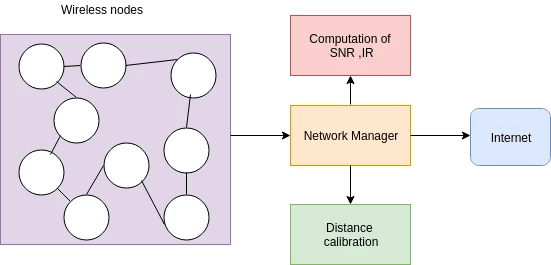NS2 Wireless Mesh Network Projects List
we are offering final year NS2 MTech Projects, NS2 IEEE Projects, IEEE NS2 Projects, NS2 MS Projects, NS2 BTech Projects, NS2 BE Projects, NS2 ME Projects, NS2 IEEE Projects, NS2 IEEE Base papers, NS2 Final Year Projects, NS2 Academic Projects, NS2 Projects, NS2 Seminar Topics,
1.Joint Routing, Rate Adaptation and Power Control for Multi-Radio Wireless Mesh Networks
Remote Mesh systems are rising as backhaul remote innovation to interface different kinds of systems to the web. The multi-radio capacity of switches in these systems upgrades the limit however expands the impedance and influences the QoS. To address this, an effective steering instrument is expected to register the ideal course. Further, the steering choices are subject to transmission rate alongside the vitality productivity. Towards this, we expand our past work of joint steering and rate adjustment with vitality improvement utilizing cross-layer system.
The cross-layer parameters are gotten to from PHY, MAC and organize layers. In this work, we outline Interference Ratio Based Rate Adaptation (IRBRA) component mutually with steering along with vitality improvement. We execute this procedure utilizing OLSR convention in NS2. The outcomes uncover that the IRBRA performs better that the structures in view of adjusted specimen rate and LD-ARF. The execution is assessed utilizing parameters like throughput, bundle misfortune, vitality utilization and deferral.

Project Overview :
An expansion in cell phones is causing colossal vitality utilization in organize. Productive vitality use in the remote work systems is been considered as the real test in directing conventions in the WMN on the grounds that after every transmission of information bundles, the vitality of the hubs used to transmit ought to be limited so that the following transmission ought to have the capacity to transmit the parcels without any blunder or unsettling influence. In this way we propose the joint approach of rate, steering and vitality improvement. With regard to upgrade the vitality utilization we consider the cross-layer approach.
System Requirements
Hardware Requirement
Main processor : Pentium IV processor 1.13 GHz
Hard disk capacity : 40GB
Cache memory : 512 MB
Monitor : LG Digital Color Monitor
Keyboard : Samsung
Mouse : Logitech
Software Requirement
Operating system : Fedora 8 (linux)
Scripting language : Network Simulator 2.33
Protocol developed : C++
Scripting : Tool Command Language
Sample Code
proc MeshRouters {} {
if { $a < [expr $rc + 1] } {
for {set i $f} {$i < $a } { incr i } {
set xx($i) [expr $xx([expr $i – 1]) + 150]
set yy($i) $yy([expr $i – 1])
$node_($i) set X_ $xx($i)
$node_($i) set Y_ $yy($i)
}
set f [expr $a + 1]
set a [expr $f + [expr $column -1]]
}
}
proc MeshClients {} {
for {set i $rc } {$i < $val(nn) } { incr i } {
set xx($i) [expr rand()*$val(x)]
set yy($i) [expr [expr rand()*300] + 200]
$ns at $tm "$node_($i) setdest $xx($i) $yy($i) 500"
Here we are finding route by using mesh function. First assigning x and y location of node in for loop. While running all nodes are in same location after we run this program all nodes are move to other location then start to communicate source to destination.
2.E-MAntNet: An ACO-Based Energy Efficient Routing Protocol for Mobile Ad Hoc Networks
In mobile ad hoc networks (MANETs), nodes are mobile and have limited energy resource that can quickly deplete due to multi-hop routing activities, which may gradually lead to an un-operational network. In the past decade, the hunt for a reliable and energy-efficient MANETs routing protocol has been extensively researched.
This paper proposes a novel AntNet-based routing scheme for MANETs (so-called MAntNet), and an its enhanced energy-aware version (so-called E-MAntNet), for which the routing decisions are facilitated based on the nodes’ residual energy. These protocols were evaluated through simulations using NS2, showing that E-MAntNet outperforms both MAntNet and E-AODV, in terms of network residual energy, network lifetime, number of established connections, and the number of dead nodes in the network, where E-AODV is an energy-aware version of AODV.
Keywords —Mobile ad hoc networks (MANETs), multi-path routing, energy aware routing, Ant Colony Optimization (ACO)
3.Re-Organizable Wireless Mesh Network Using ARS
In recent year wireless communication is most widely used, but there is also traffic in surrounding environment, while transferring the data from source to destination. This can be possible due to channel interference, various obstacles, which result in link failure causes poor performance, require expensive network management for their recovery.
To maintain the network performance Autonomous network reconfiguration system (ARS) is used which autonomously reconfigure and recover from local link failure. Through NS2 based simulation ARS has been implemented and evaluated. ARS improves the channel efficiency better than other recovery methods for example reroute and greedy channel
4.Transmission Energy Management for Wireless Ad-hoc Network
Remaining energy is the energy of the nodes after trans receiving data in network. This energy of nodes is the main parameter to control the energy consumption of wireless mobile ad-hoc networks. An optimum remaining energy is required to maintain life of network. In this paper, transmission energy management is proposed to optimize energy consumption of nodes in network. Transmission energy consumption is inversely proportional to remaining energy of node in network. NS2 simulation model is used to analysis energy consumption of nodes in network and results show that varying the transition and receiving energy affects the remaining energy of nodes in network
5.Impact of realistic simulation on the evaluation of mobile Ad-hoc routing protocols
Today’s advanced simulators facilitate thorough studies on Vehicular Ad-hoc NETworks (VANETs).However the choice of the physical layer and the mobility models in such simulators is a crucial issue that greatly impacts the results. Realistic simulation of routing protocols in VANETs is still an open question.Indeed, only a few works address routing protocols comparison performed under realistic conditions.
This paper compares common reactive, pro-active, hybrid and geographic routing protocols by using a simulation platform integrating a realistic physical layer and mobility models. It also presents and analyzes several reactive protocols enhancements propositions dedicated to the VANETs context such as multi-path routing, but also protocols tuning which allows it to adapt faster. They have all received a lot of attention and are typically proposed to increase the reliability of data transmission.
This paper study the behavior of each protocol in different situations and analysed their advantages and drawbacks. Results presented in this paper gives an important explanation on the contradictory results found in similar works. Finally, our realistic simulations show that reactive protocols are the best suited for VANETs, and more especially the DYMO protocol
6.PSR: A Lightweight Proactive Source Routing Protocol For Mobile Ad Hoc Networks
Opportunistic data forwarding has drawn much attention in the research community of multihop wireless networking, with most research conducted for stationary wireless networks. One of the reasons why opportunistic data forwarding has not been widely utilized in mobile ad hoc networks (MANETs) is the lack of an efficient lightweight proactive routing scheme with strong source routing capability. In this paper, we propose a lightweight proactive source routing (PSR) protocol.
PSR can maintain more network topology information than distance vector (DV) routing to facilitate source routing, although it has much smaller overhead than traditional DV-based protocols [e.g., destination-sequenced DV (DSDV)], link state (LS)-based routing [e.g., optimized link state routing (OLSR)], and reactive source routing [e.g., dynamic source routing (DSR)]. Our tests using computer simulation in Network Simulator 2 (ns-2) indicate that the overhead in PSR is only a fraction of the overhead of these baseline protocols, and PSR yields similar or better data transportation performance than these baseline protocols
7.Clustering of Mobile Ad Hoc Networks: An Approach for Black Hole Prevention
This paper addresses security and performance issues of MANET. A novel cluster oriented concept is proposed to
enhance security and efficiency of the network. Proposed strategy insures the optimum performance of MANET in presence of black hole attack. The simulation of the proposed methodology is carried out using NS2 network simulator and the simulation results reflects the performance of scheme for detection and prevention of the black hole



Leave Your Comment Here